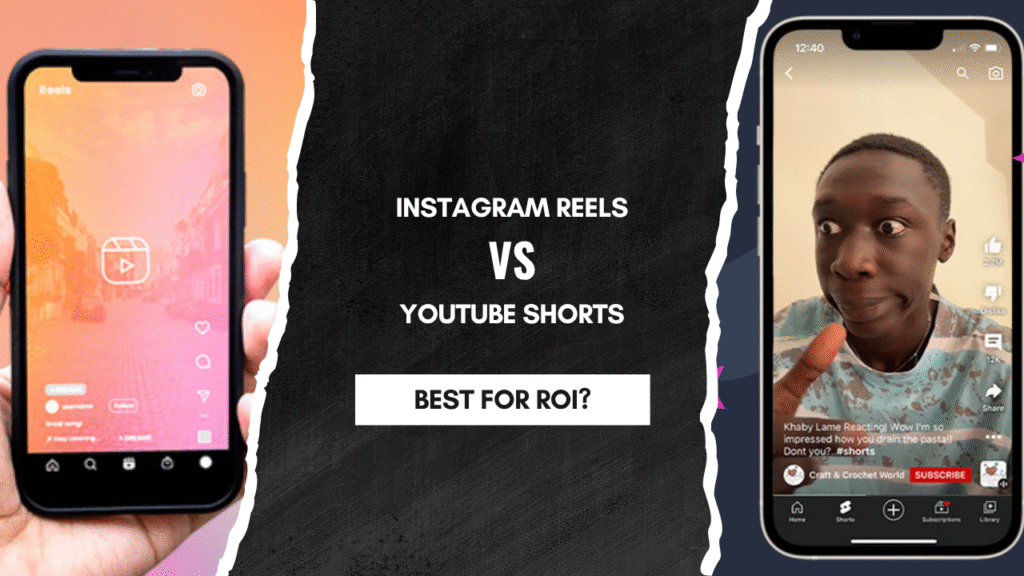If content is king, then short-form video is the crown it wears in 2025.
From 15-second transformations to viral product drops, the battle of Instagram Reels vs Shorts Marketing is reshaping how brands sell, scale, and succeed online.

But here’s the real question every marketer, creator, and brand owner is asking:
Which platform actually gives better ROI—more reach, real engagement, and tangible conversions?
Spoiler alert: It’s not just about views. It’s about who’s watching, what they’re doing after, and where your content lives longer.
In this blog, we’ll break down platform power, audience behavior, ad performance, and strategic wins to help you choose where to put your video marketing energy (and budget). Whether you’re team Reels or Shorts—or somewhere in between—this deep dive will answer every doubt and decode what works now.
The Rise of Short-Form Content
The battle of “Reels vs Shorts marketing” didn’t just happen overnight. With dwindling attention spans and the boom of platforms like TikTok, users now prefer bite-sized videos packed with entertainment or value. Brands had to pivot fast—and both Instagram and YouTube launched their own versions of short videos.
Today, Instagram Reels and YouTube Shorts dominate the marketing funnel. But while both cater to short-form content, the way they operate—and convert—is entirely different.
User Base & Demographics: Who’s Watching?
Instagram Reels
- Primary user age: 18–35
- Highly active Gen Z and Millennials
- Content leans toward lifestyle, fashion, food, beauty, and entertainment
- Strong influence culture—users follow creators and brands based on visual appeal
YouTube Shorts
- Primary user age: 18–45
- Wider demographic reach, including professionals and learners
- Often educational, tutorial-based, or entertainment-focused
- Strong SEO advantage due to Google search integration
Takeaway: If your brand targets youth, Instagram might offer better engagement. If you’re educating or targeting a wider, knowledge-driven audience—YouTube Shorts could win.
Monetization & ROI Potential
Instagram Reels
- Limited direct monetization unless using affiliate links or paid partnerships
- High engagement but lower CTR (click-through rate)
- Best for visibility, brand awareness, and influencer collaborations
YouTube Shorts
- YouTube’s Partner Program now allows monetization even for Shorts
- Easier to link to websites, channels, or other videos
- Strong backend analytics and retargeting through Google Ads
Marketing Tip: For direct conversions and long-term monetization, YouTube Shorts is more ROI-focused. For influencer-led campaigns and top-of-the-funnel awareness, Instagram Reels shines.
Algorithm & Reach: Who Does It Better?
Instagram Reels
- Relies heavily on trending audio, hashtags, and engagement rate
- Viral potential is high, but content life cycle is short
- Heavily driven by aesthetics and consistency
YouTube Shorts
- Relies on watch time, retention, and viewer interaction (likes, shares, comments)
- Easier for “evergreen content” to perform well over time
- YouTube’s search engine support helps videos show up even months later
SEO Advantage: Shorts offer better long-term discoverability. For brands optimizing for search-based traffic, YouTube is unbeatable.
Engagement & User Behavior
Reels Engagement
- Scroll-fast behavior, high likes and shares
- Hashtags like #trendingreels, #reelsinstagram, #viralreels boost reach
- Best for emotional and entertaining content
Shorts Engagement
- More time spent per video
- Better space for storytelling and “how-to” content
- Works well with educational and product explainers
Hot Search Terms:
Use these in your video description, blog SEO, or tags to maximize results:
- “reels vs shorts marketing 2025”
- “best short video platform for business”
- “Instagram vs YouTube ROI”
- “short-form video marketing strategy”
Ads & Brand Promotion
Instagram Reels Ads
- Great for impulse buys, product teasers, and influencer partnerships
- Higher cost per impression (CPM) compared to Shorts
- Perfect for brands with aesthetic or lifestyle-driven products
YouTube Shorts Ads
- Lower CPM and better audience targeting via Google Ads
- Integrated with broader video strategy (playlists, long-form content)
- More flexibility in lead generation, conversions, and retargeting
Pro Tip: YouTube Shorts = deeper funnel. You can move viewers from Shorts to long videos to website—a complete customer journey.
Which Platform Should You Choose?
Here’s a quick decision guide based on your marketing goal:
| Goal | Go with Instagram Reels | Go with YouTube Shorts |
| Brand Awareness | ✅ Yes | ✅ Yes |
| Product Promotion | ✅ Yes | ✅ Yes |
| Lead Generation | ❌ Limited | ✅ Strong |
| Direct Monetization | ❌ Limited | ✅ YouTube Partner Program |
| SEO + Long-Term Visibility | ❌ | ✅ |
| Influencer Collaborations | ✅ Popular | ❌ Less Common |
Final Verdict: Reels vs Shorts Marketing
In 2025, both Instagram Reels and YouTube Shorts are non-negotiables in a brand’s content strategy. But if you’re looking for branding, virality, and high engagement, Reels is your playground. If you want long-term ROI, monetization, and search visibility, YouTube Shorts is where you should invest more energy.
Ideally, the best strategy is a hybrid model—create native content for both platforms, tailor messaging according to platform behavior, and use cross-promotion to maximize your content lifespan.
